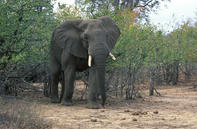
Elephants are a keystone species, meaning that they influence the healthy functioning of ecosystems and even the survival of particular species. Due to their enormous size and energy requirements, elephants alter habitats. They are a “driving force” in the maintenance of the bushveld habitat type through the cropping of woody vegetation which prevents it reaching a forest climax (while fire keeps the grass at a competitive equilibrium).
Elephants are destructive feeders and push trees over to access green leaves on the crown. They debark trees to access the inner cambium layer (vascular tissue) which contains the water and nutrients being transported up or down the stem of the tree (depending on the season).
If debarking encircles the trunk (ring-barking), the trees can no longer transport nutrients from the roots to the leaves and will die. Even in social displays, bulls may push trees over to intimidate rivals.
Keystone Species

These apparently wasteful actions have positive ecological repercussions. Fallen trees provide browse at ground level to smaller herbivores and they also create micro habitats for the breeding and survival of ground creatures like rodents, reptiles, small mammals and birds especially once the grass grows up through the branches and creates a tangle impenetrable to larger predators.
Nutrients from fallen trees are also recycled back into the soil through decay, as ash after fires or by termites which feed on the wood. Fruit knocked out of trees during elephants feeding activities are available to other smaller animals too.
By Megan Emmett